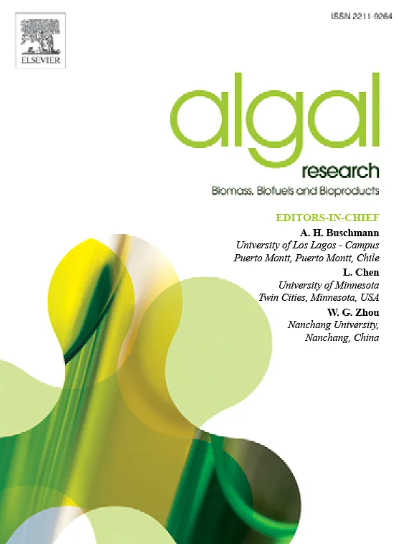小球藻多糖的提取纯化及抗氧化活性研究
IF 4.5
2区 生物学
Q1 BIOTECHNOLOGY & APPLIED MICROBIOLOGY
Algal Research-Biomass Biofuels and Bioproducts
Pub Date : 2025-05-01
DOI:10.1016/j.algal.2025.104077
引用次数: 0
摘要
小球藻多糖的抗氧化活性在医疗保健领域具有广阔的应用前景。超声、热水、微波、冻融、碱和酶辅助提取等方法通过优化提取条件,可获得较高的多糖提取效率。但是,这些方法可能由于时间过长(如6小时)或温度过高(如170℃)而存在多糖降解、多糖结构和生物活性发生变化的风险。因此,在优化过程中需要进一步研究温和、绿色、高效的提取条件。本研究采用碱法、超声法、反复冻融法和热水法四种传统方法及其组合提取小球藻多糖,并利用响应面法(CCD)优化多糖提取率最高的方法(碱/热水法)的提取工艺。比较了Sevage试剂、三氯乙酸(TCA)和盐析对碱-热水法(AHP)提取的多糖的蛋白质去除率。采用DEAE-52纤维素柱层析法分离纯化了中性多糖(AHP-1)和酸性多糖(AHP-2和AHP-3),并对其抗氧化活性进行了研究。结果表明,Sevage试剂对AHP的蛋白去除率最高(94.6%,w/w)。此外,三种多糖组分具有不同的DPPH和ABTS自由基清除活性和铁还原能力(AHP-2 >;AHP-3祝辞AHP-1)。AHP-2具有开发天然抗氧化剂的巨大潜力,可作为功能性食品的组成部分。综上所述,本研究通过提取纯化得到小球藻多糖AHP提取率高、纯度高,且AHP具有较高的抗氧化活性。结果表明,层次分析法在天然抗氧化剂的开发中具有很大的潜力,为其在食品、医药、美容等行业的应用奠定了基础。本文章由计算机程序翻译,如有差异,请以英文原文为准。
Extraction, purification and antioxidant activity of Chlorella polysaccharide
The antioxidant activity of Chlorella polysaccharide has broad application prospect in healthcare. Ultrasound, hot water, microwave, freeze-thaw, alkali and enzyme assisted extraction methods can achieve high extraction efficiency of polysaccharide by optimizing extraction conditions. However, these methods may have risks of polysaccharide degradation, changes in polysaccharide structure and biological activity due to too long time (such as 6 h) or too high temperature (such as 170 °C). Therefore, mild, green and efficient extraction conditions need to be further studied during optimization process. This study extracted polysaccharide from Chlorella using four traditional methods (alkali, ultrasound, repeated freeze-thaw and hot water) and their combination, and optimized extraction process for the method with the highest polysaccharide extraction rate (alkali/hot water) using response surface methodology (Central Composite Design, CCD). We compared protein removal efficiency of Sevage reagent, trichloroacetic acid (TCA) and salting out for polysaccharide extracted by alkali-hot water method (AHP). Three components including neutral polysaccharide (AHP-1) and acidic polysaccharide (AHP-2 and AHP-3), were isolated and purified by DEAE-52 cellulose column chromatography, and their antioxidant activities were investigated. The results showed that Sevage reagent had the best protein removal efficiency (94.6 %, w/w) for AHP. In addition, three polysaccharide components exhibited different DPPH and ABTS free radical scavenging activities and iron reducing abilities (AHP-2 > AHP-3 > AHP-1). AHP-2 has great potential for the development of natural antioxidants and may serve as a component of functional foods. In summary, this study obtained high extraction rate and purity of Chlorella polysaccharide AHP through extraction and purification, and AHP exhibited high antioxidant activities. The results indicate that AHP has great potential for the development of natural antioxidants, laying the foundation for its application in food, medicine and beauty industries.
求助全文
通过发布文献求助,成功后即可免费获取论文全文。
去求助
来源期刊

Algal Research-Biomass Biofuels and Bioproducts
BIOTECHNOLOGY & APPLIED MICROBIOLOGY-
CiteScore
9.40
自引率
7.80%
发文量
332
期刊介绍:
Algal Research is an international phycology journal covering all areas of emerging technologies in algae biology, biomass production, cultivation, harvesting, extraction, bioproducts, biorefinery, engineering, and econometrics. Algae is defined to include cyanobacteria, microalgae, and protists and symbionts of interest in biotechnology. The journal publishes original research and reviews for the following scope: algal biology, including but not exclusive to: phylogeny, biodiversity, molecular traits, metabolic regulation, and genetic engineering, algal cultivation, e.g. phototrophic systems, heterotrophic systems, and mixotrophic systems, algal harvesting and extraction systems, biotechnology to convert algal biomass and components into biofuels and bioproducts, e.g., nutraceuticals, pharmaceuticals, animal feed, plastics, etc. algal products and their economic assessment
 求助内容:
求助内容: 应助结果提醒方式:
应助结果提醒方式:


